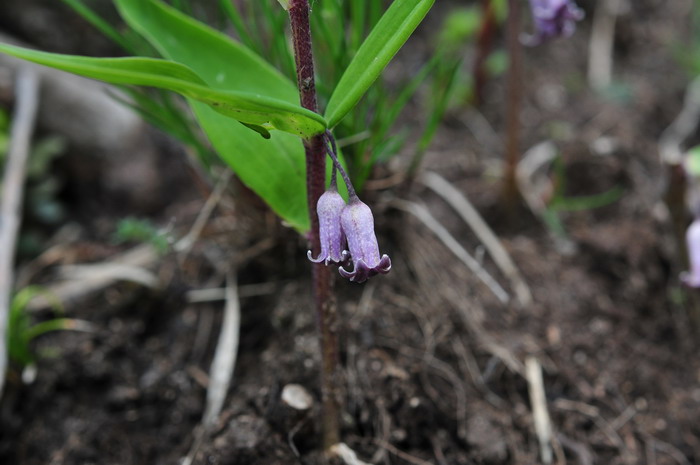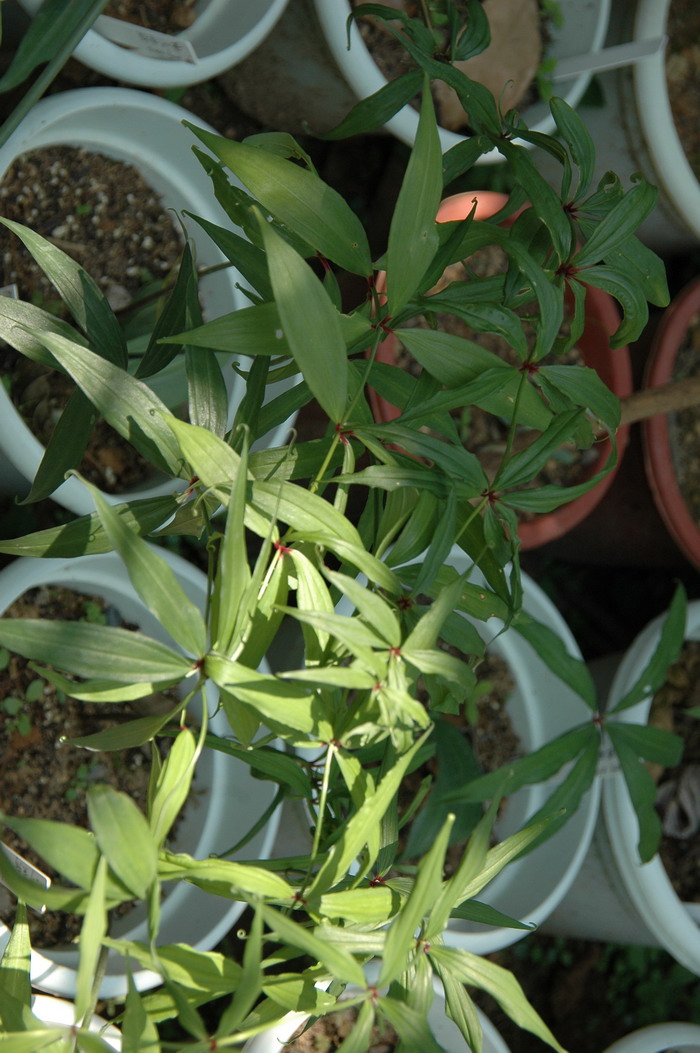轮叶黄精Polygonatum verticillatum
中文名(Chinese Name):轮叶黄精
学名(Scientific Name):Polygonatum verticillatum (Linn.) All.
英文名(English Common Name):
别名(Chinese Common Name):红果黄精
异名(Synonym):Convallaria verticillata L. Polygonatum erythrocarpum Hua Polygonatum kansuense Maxim. ex Batalin Polygonatum minutiflorum H. Lév. Campydorum verticillatum (L.) Salisb. Polygonatum macrophyllum Sweet Polygonatum jacquemontianum Kunth Polygonatum leptophyllum (D.Don) Royle Sigillum verticillatum (L.) Montandon Troxilanthes angustifolia Raf. Convallaria leptophylla D.Don Convallaria stellifolia Peterm. Evallaria verticillata (L.) Neck. Polygonatum verticillatum var. gracile Baker ex Aitch. Polygonatum verticillatum subsp. stellifolium (Peterm.) K.Richt.
科属(Family & Genus):百合科(Liliaceae)黄精属
形态特征(Description):根状茎的“节间”长2-3厘米,一头粗,一头较细,粗的一头有短分枝,直径7- 15毫米,少有根状茎为连珠状。茎高(20-)40-80厘米。叶通常为3叶轮生,或间有 少数对生或互生的,少有全株为对生的,矩圆状披针形(长6-10厘米,宽2-3厘米) 至条状披针形或条形•(长达10厘米,宽仅5毫米),先端尖至渐尖。花单朵或2-(3- 4)朵成花序,总花梗长1-2厘米,花梗(指生于花序上的)长3-10毫米,俯垂;苞片 一不存在,或微小而生于花梗上;花被淡黄色或淡紫色,全长8-12毫米,裂片长2-3毫 米;花丝长0.5-1(-2)毫米,花药长约2.5毫米;子房长约3毫米,具约与之等长或 稍短的花柱。浆果红色,直径6-9毫米,具6-12颗种子。花期5-6月,果期8-10月。
分布(Distribution):产西藏、云南、四川、青海、甘肃、陕西、山西。生林下或山坡草地,海拔2100-4000米。欧洲经西 南亚至尼泊尔、不丹均有分布。
用途(Use):根状茎也作黄精用。
引自植物志英文版: FOC Vol. 24 Page 230
Polygonatum verticillatum (Linnaeus) Allioni, Fl. Pedem. 1: 131. 1785.
轮叶黄精 lun ye huang jing | Liliaceae | Polygonatum
Convallaria verticillata Linnaeus, Sp. Pl. 1: 315. 1753; Polygonatum erythrocarpum Hua; P. kansuense Maximowicz ex Batalin; P. minutiflorum H. Léveillé.
Rhizome usually shortly branched, usually tuberous terete, very rarely moniliform, 0.7--1.5 cm thick. Stem erect, (20--)40--80 cm, glabrous. Leaves in whorls of 3, occasionally alternate near base of stem, sometimes opposite near apex of stem, subsessile, oblong-lanceolate to linear, 6--10 × 0.5--3 cm, apex acute to acuminate, not cirrose. Inflorescences 1- or 2(--4)-flowered; peduncle 1--2 cm; bracts small or absent. Flowers pendulous; pedicel 3--10 mm. Perianth pale purple (or white or pale yellow, but probably only when dry), cylindric, 0.8--1.2 cm; lobes 2--3 mm. Filaments 0.5--1(--2) mm, papillose; anthers ca. 2.5 mm. Ovary ca. 3 mm. Style 2.5--3 mm. Berries red, 6--9 mm in diam., 6--12-seeded. Fl. May--Jun, fr. Aug--Oct. 2 n = (24), 28, 30, (56*), 60, (64, 66, 84), ca. 90.
Forests, grassy slopes; 2100--4000 m. Gansu, Nei Mongol, Qinghai, Shaanxi, Shanxi, Sichuan, Xizang, Yunnan [Afghanistan, Bhutan, Nepal, Pakistan, Russia, Sikkim; SW Asia, Europe].
Rudolf Kamelin (pers. comm.) believes that Polygonatum verticillatum is absent from China, and that the plants there are instead P. kansuense ( P. erythrocarpum). In SW Asia and Europe, P. verticillatum has leaves in whorls of 5--7, inflorescences mostly 3- or 4-flowered, perianth white, and berries dark blue-green (although one of us (Tamura) has collected P. verticillatum with orange berries in S Denmark: Tamura & Kubitzki 3425 (KYO)). Tamura considers that P. verticillatum of the present sense may be a species in which different lineages are lumped. However, Chen and Tamura together decided to maintain the present circumscription until sufficient morphological variation data have accumulated. Kamelin also notes that Polygonatum minutiflorum, regarded here as a synonym of P. verticillatum may instead be synonymous with P. gracile in which case the former name, published in 1915, would have priority.

 (责任编辑:徐晔春)
(责任编辑:徐晔春)
学名(Scientific Name):Polygonatum verticillatum (Linn.) All.
英文名(English Common Name):
别名(Chinese Common Name):红果黄精
异名(Synonym):Convallaria verticillata L. Polygonatum erythrocarpum Hua Polygonatum kansuense Maxim. ex Batalin Polygonatum minutiflorum H. Lév. Campydorum verticillatum (L.) Salisb. Polygonatum macrophyllum Sweet Polygonatum jacquemontianum Kunth Polygonatum leptophyllum (D.Don) Royle Sigillum verticillatum (L.) Montandon Troxilanthes angustifolia Raf. Convallaria leptophylla D.Don Convallaria stellifolia Peterm. Evallaria verticillata (L.) Neck. Polygonatum verticillatum var. gracile Baker ex Aitch. Polygonatum verticillatum subsp. stellifolium (Peterm.) K.Richt.
科属(Family & Genus):百合科(Liliaceae)黄精属
形态特征(Description):根状茎的“节间”长2-3厘米,一头粗,一头较细,粗的一头有短分枝,直径7- 15毫米,少有根状茎为连珠状。茎高(20-)40-80厘米。叶通常为3叶轮生,或间有 少数对生或互生的,少有全株为对生的,矩圆状披针形(长6-10厘米,宽2-3厘米) 至条状披针形或条形•(长达10厘米,宽仅5毫米),先端尖至渐尖。花单朵或2-(3- 4)朵成花序,总花梗长1-2厘米,花梗(指生于花序上的)长3-10毫米,俯垂;苞片 一不存在,或微小而生于花梗上;花被淡黄色或淡紫色,全长8-12毫米,裂片长2-3毫 米;花丝长0.5-1(-2)毫米,花药长约2.5毫米;子房长约3毫米,具约与之等长或 稍短的花柱。浆果红色,直径6-9毫米,具6-12颗种子。花期5-6月,果期8-10月。
分布(Distribution):产西藏、云南、四川、青海、甘肃、陕西、山西。生林下或山坡草地,海拔2100-4000米。欧洲经西 南亚至尼泊尔、不丹均有分布。
用途(Use):根状茎也作黄精用。
引自植物志英文版: FOC Vol. 24 Page 230
Polygonatum verticillatum (Linnaeus) Allioni, Fl. Pedem. 1: 131. 1785.
轮叶黄精 lun ye huang jing | Liliaceae | Polygonatum
Convallaria verticillata Linnaeus, Sp. Pl. 1: 315. 1753; Polygonatum erythrocarpum Hua; P. kansuense Maximowicz ex Batalin; P. minutiflorum H. Léveillé.
Rhizome usually shortly branched, usually tuberous terete, very rarely moniliform, 0.7--1.5 cm thick. Stem erect, (20--)40--80 cm, glabrous. Leaves in whorls of 3, occasionally alternate near base of stem, sometimes opposite near apex of stem, subsessile, oblong-lanceolate to linear, 6--10 × 0.5--3 cm, apex acute to acuminate, not cirrose. Inflorescences 1- or 2(--4)-flowered; peduncle 1--2 cm; bracts small or absent. Flowers pendulous; pedicel 3--10 mm. Perianth pale purple (or white or pale yellow, but probably only when dry), cylindric, 0.8--1.2 cm; lobes 2--3 mm. Filaments 0.5--1(--2) mm, papillose; anthers ca. 2.5 mm. Ovary ca. 3 mm. Style 2.5--3 mm. Berries red, 6--9 mm in diam., 6--12-seeded. Fl. May--Jun, fr. Aug--Oct. 2 n = (24), 28, 30, (56*), 60, (64, 66, 84), ca. 90.
Forests, grassy slopes; 2100--4000 m. Gansu, Nei Mongol, Qinghai, Shaanxi, Shanxi, Sichuan, Xizang, Yunnan [Afghanistan, Bhutan, Nepal, Pakistan, Russia, Sikkim; SW Asia, Europe].
Rudolf Kamelin (pers. comm.) believes that Polygonatum verticillatum is absent from China, and that the plants there are instead P. kansuense ( P. erythrocarpum). In SW Asia and Europe, P. verticillatum has leaves in whorls of 5--7, inflorescences mostly 3- or 4-flowered, perianth white, and berries dark blue-green (although one of us (Tamura) has collected P. verticillatum with orange berries in S Denmark: Tamura & Kubitzki 3425 (KYO)). Tamura considers that P. verticillatum of the present sense may be a species in which different lineages are lumped. However, Chen and Tamura together decided to maintain the present circumscription until sufficient morphological variation data have accumulated. Kamelin also notes that Polygonatum minutiflorum, regarded here as a synonym of P. verticillatum may instead be synonymous with P. gracile in which case the former name, published in 1915, would have priority.
踩一下[2]

顶一下[2]